American Kestrel male
July 17, 2014 in American Kestrel
July 17, 2014 in American Kestrel
July 7, 2014 in American Kestrel
June 26, 2014 in American Kestrel
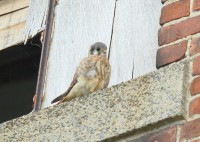 Flight agility increases noticeably during first week after nest departure, as flutter-glide is mostly replaced by deep wing-beats. Young appear hyperactive, changing perches frequently, attempting to pounce on various objects (including butterflies), performing exaggerated head-bobbing and tail-pumping intention movements, and emitting whine calls. Initially, parents deliver food to young; fledglings approach parents for food exchange by 1–2 wk postfledging. In post fledging mode we look for: perch-resting and preening to decrease, while perch-hunting, flying, and eating self-captured prey increase. Perch-hunting success peaks at 3 weeks, at which time begging behavior ceases. This parent and young were seen just east of the 250 Canal St. complex in Lawrence.
Flight agility increases noticeably during first week after nest departure, as flutter-glide is mostly replaced by deep wing-beats. Young appear hyperactive, changing perches frequently, attempting to pounce on various objects (including butterflies), performing exaggerated head-bobbing and tail-pumping intention movements, and emitting whine calls. Initially, parents deliver food to young; fledglings approach parents for food exchange by 1–2 wk postfledging. In post fledging mode we look for: perch-resting and preening to decrease, while perch-hunting, flying, and eating self-captured prey increase. Perch-hunting success peaks at 3 weeks, at which time begging behavior ceases. This parent and young were seen just east of the 250 Canal St. complex in Lawrence.
April 28, 2014 in American Kestrel
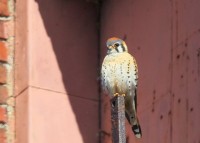 The Kestrels have returned again to Lawrence for another breeding season! Today was the first sighting of a male kestrel near the Duck Bridge along the Merrimack River.
The Kestrels have returned again to Lawrence for another breeding season! Today was the first sighting of a male kestrel near the Duck Bridge along the Merrimack River.
According to Mass Audubon, the adult male, which has blue wings, two sharp, vertical, black stripes contrasting against a light face, and a bright rufous tail, is certainly the most colorful of North American hawks. The somewhat larger female is not as brilliant as the male and has its upperparts entirely rufous, and barred with black. Kestrels tend to perch high and conspicuously in the open, making them easily visible. They can be tamed readily and will reproduce in confinement. Many falconers have noted that the small males are more docile and tractable than the females.
Spring migration occurs mainly during March and April, and by the latter month local breeders are on their territories at woodland borders, fields, pastures, and the edges of highways. As the breeding season approaches, kestrels abandon their solitary winter habits. Members of a pair often perch side by side, and courtship consists of aerial displays by the male above a perched or flying female. The male ascends on rapidly fluttering wings and then plunges steeply, giving the familiar, repetitive killy-killy or kee-kee call, which is used not only in courtship but also at other times of excitement. Copulation during this period is frequent and precedes egg laying by several weeks.
July 8, 2013 in American Kestrel
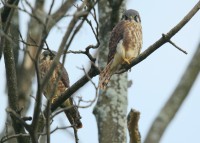 After a long waiting period with very regular intervals of watching, finally had a chance to see the two female Kestrel fledglings from this new nest location. They perched in the leafless nearby tree where the parents regularly perch during the day. Althought tough to find at times due to the many branches and their perfect coloration, quite a treat to get these looks!
After a long waiting period with very regular intervals of watching, finally had a chance to see the two female Kestrel fledglings from this new nest location. They perched in the leafless nearby tree where the parents regularly perch during the day. Althought tough to find at times due to the many branches and their perfect coloration, quite a treat to get these looks!
April 25, 2013 in American Kestrel
April 18, 2013 in American Kestrel
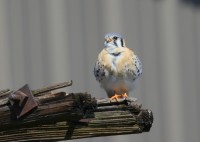 An unexpected surprise to see a pair of Kestrels newly around the 2012 nest location on Merrimack Street. Kestrel pairs ahve been observed in multiple nearby locations over past few weeks. they have stayed a while and then seemingly moved on. This pair may be setting up to use this nest location. It is uncertain as to if this is a returning pair or new pair. The pair last year had no chicks and vacated nest box very early. A nearby Kestrel observer indicated that he may have found the 2012 nesting pair in separate locations in late summer, both with broken necks. May have been the work of the nearby falcons.
An unexpected surprise to see a pair of Kestrels newly around the 2012 nest location on Merrimack Street. Kestrel pairs ahve been observed in multiple nearby locations over past few weeks. they have stayed a while and then seemingly moved on. This pair may be setting up to use this nest location. It is uncertain as to if this is a returning pair or new pair. The pair last year had no chicks and vacated nest box very early. A nearby Kestrel observer indicated that he may have found the 2012 nesting pair in separate locations in late summer, both with broken necks. May have been the work of the nearby falcons.
7 photos posted: http://www.pbase.com/birdshots/image/149753294 Click “next” in upper right corner to advance frames….enjoy!
April 9, 2013 in American Kestrel
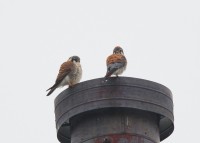 A pair of American Kestrels were seen atop a rooftop exhaust stack at the east end of the Union Crossing apartment complex overlooking the Merrimack River. This pair have been observed in multiple nearby locations, perhaps looking to finalize a nest location for the breeding season. It was an overcast morning and the photo was from a distance in low light conditions.
A pair of American Kestrels were seen atop a rooftop exhaust stack at the east end of the Union Crossing apartment complex overlooking the Merrimack River. This pair have been observed in multiple nearby locations, perhaps looking to finalize a nest location for the breeding season. It was an overcast morning and the photo was from a distance in low light conditions.
April 1, 2013 in American Kestrel
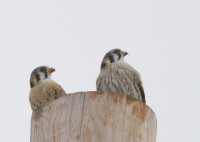 In a new location for 2013, spotted a male and female Kestrel pair perched atop a telephone pole at the east end of Canal St. in Lawrence. They were very cute perched atop the pole and they were keenly watching all avain passersby including a Red-tailed Hawk that caught their rapt attention! This was first sighting of this pair and hopes run high that they be attempting to settle in a nest nearby….stay tuned!
In a new location for 2013, spotted a male and female Kestrel pair perched atop a telephone pole at the east end of Canal St. in Lawrence. They were very cute perched atop the pole and they were keenly watching all avain passersby including a Red-tailed Hawk that caught their rapt attention! This was first sighting of this pair and hopes run high that they be attempting to settle in a nest nearby….stay tuned!
A few more photos posted: http://www.pbase.com/birdshots/image/149480026 Click “next” in upper rightto advance frames….enjoy!
June 1, 2012 in Nearby Landbirds
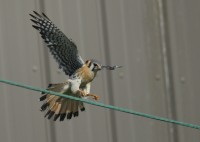 The female kestrel lays 4-6 eggs, 1 every other day. She typically begins incubation upon laying the penultimate egg. The incubation period is approximately 30 days and the nestlings fledge in 28-31 days. They are dependent on their parents for another 12-14 days. Up to 75% of the young may die during their first year. Mortality rate drops to perhaps 10-20% per year as young falcons fine-tune their survival skills.
The female kestrel lays 4-6 eggs, 1 every other day. She typically begins incubation upon laying the penultimate egg. The incubation period is approximately 30 days and the nestlings fledge in 28-31 days. They are dependent on their parents for another 12-14 days. Up to 75% of the young may die during their first year. Mortality rate drops to perhaps 10-20% per year as young falcons fine-tune their survival skills.
American Kestrels prefer open and partly open areas with scattered trees. They are a secondary cavity nester and are the only North American falcon or hawk to nest in cavities. They use woodpecker holes, natural cavities in trees, crevices in rocks, openings in buildings and nest boxes.
Additional photos including many flights shots posted online: http://www.pbase.com/birdshots/image/143865184